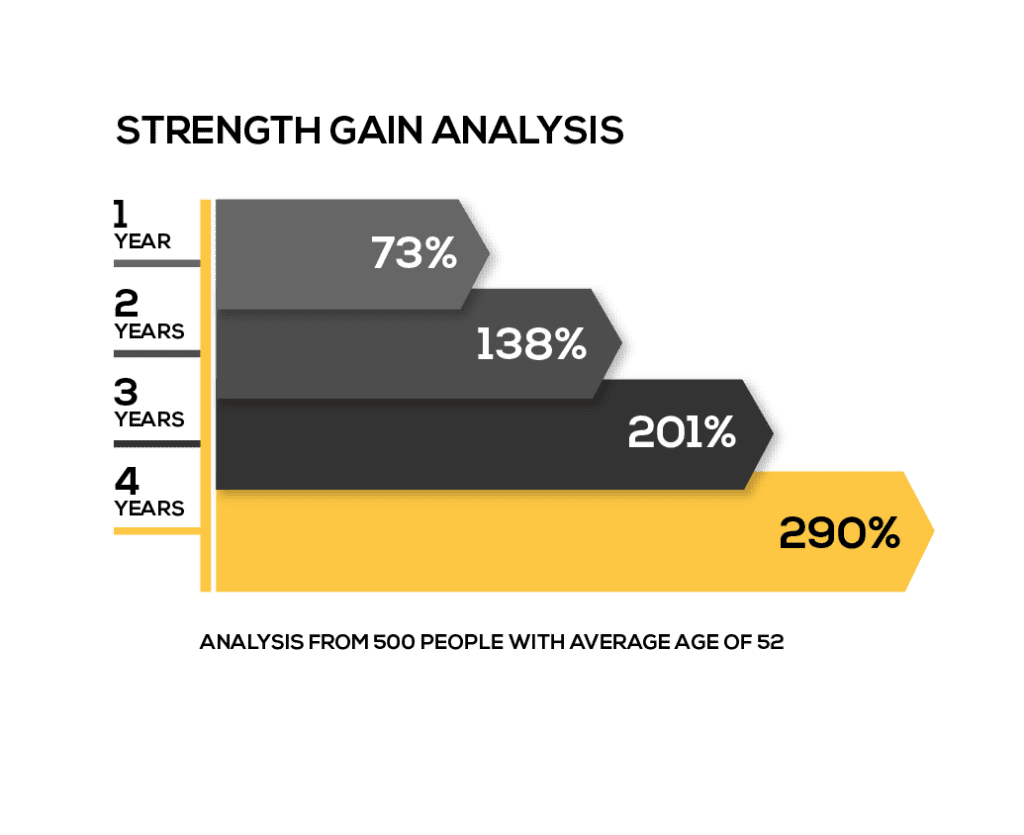Why Do We Get Weaker As We Age?
Have you ever wondered why after about age thirty, no matter how hard you push yourself exercising at home or the gym, there seems to be a limit on the strength you can muster, and every year you seem to get weaker?
The progressive loss of muscle mass and strength that occurs with aging, referred to as sarcopenia and dynapenia, is influenced by several key factors:
Aging: Natural aging is the primary cause of strength loss, characterized by a gradual decline in muscle fibres, especially fast-twitch muscle fibres, leading to reduced muscle mass and strength.
Physical Inactivity: Sedentary lifestyles contribute significantly to the development of strength loss, as lack of exercise leads to faster muscle loss.
Inadequate Nutrition: Inadequate intake of protein and essential nutrients can lead to muscle degradation, a concern especially for older adults facing reduced appetite and dietary limitations. The rising consumption of fast and ultra-processed foods (UPFs) contributes to this problem for many people.
Poor Gastrointestinal Health: As you age, maintaining your gastrointestinal health is crucial for nutrient absorption, with the gut biome playing a key role in digesting food, synthesising vitamins, and hormone production, all vital for muscle and bone strength, immune response, and overall mental and physical well-being. Prioritising a balanced diet rich in nutrients, fibre, prebiotics, and probiotics, complemented by regular exercise, is essential for gut health and optimal bodily function.
Hormonal Changes: Ageing, particularly after menopause and andropause, is associated with changes in hormone levels, including decreased production of growth hormone, testosterone, and estrogen, which play crucial roles in muscle health.
Chronic Diseases: Conditions such as diabetes, heart disease, and chronic inflammation can contribute to the development of sarcopenia by affecting muscle metabolism and function.
Neuromuscular Degradation: The deterioration of your central and peripheral nervous system including neuromuscular junctions, where nerve cells connect with the muscles they control, also contributes to strength loss, affecting muscle strength and coordination.
These factors combined underscore the multifactorial nature of muscle strength loss as we age, highlighting the importance of addressing lifestyle, dietary, and healthcare strategies to mitigate its impact.
Our In-Built Force Limiter:
Our brains have a natural “muscle force limiter” controlled by our central nervous system. This protective mechanism prevents us from causing self-harm, such as tearing tendons, snapping ligaments, or damaging muscles, especially when we exert ourselves too much.
This biological safeguard limits our physical strength to prevent injury, becoming more cautious as we age due to bone density loss and weaker tendons and ligaments. For most people this leads to a 10% decrease in muscle strength every decade.
However, what if we could safely overcome this barrier and rejuvenate our strength?
Let’s explore how OsteoStrong® and some other strategies may help.
Eat More Protein for Bone and Muscle Health
As we age, most of us tend to eat less food and the food we eat has less quality protein. Studies have shown, the average Australian man consumes roughly 100g of protein per day, and the average Australian woman consumes around 70g a day, but less as we age.
Proteins and their essential amino acids play a crucial role in maintaining bone and muscle health, as they provide the necessary building blocks for strength and repair.
The Recommended Dietary Allowance (RDA) for protein, set over 60 years ago at 0.8 grams per kilogram of body weight daily, aims to prevent illness and malnutrition rather than enhance musculoskeletal health. Originating from nitrogen balance studies, this method, now known for its limitations, estimates dietary protein needs by balancing nitrogen intake with excretion to gauge protein status.
In more recent studies it has been found that a much higher protein intake is needed, particularly as we age (1).
Experts in the field of protein and aging now recommend a protein intake between 1.2 and 2.0 g/kg/day, and higher for elderly adults and those individuals experiencing low bone density and reduced muscle mass.
Based on this information, a good guide for people with poor bone health is;
1.2 to 1.5 grams of bioavailable complete protein per lean kg of body weight per day.
Most adult Australians eat less protein than this, leading to growing problems with muscle and bone health. These are vital for maintaining strength and preventing falls and fractures, especially as life expectancy increases.
Protein quality and bioavailability are also critical for musculoskeletal health. While plant-based diets offer acceptable protein sources, ensuring sufficient intake of all essential amino acids can be challenging, potentially leading to deficiencies. It’s vital for individuals on vegan or vegetarian diets to plan their meals thoughtfully and supplement if needed to meet their protein requirements.
Why the Quality of our Food and Protein Matters
One of the newer nutritional catch phrases today is “We are what we eat, eats”.
Every day we hear about farm soils becoming degraded, synthetic fertilisers and pesticides, plants and animals genetically modified for higher yields, highly processed and refined packaged foods which are high in calories but low in nutrition, and consumer shifts to more convenience foods high in sugar and processed seed oils.
The decline in the quality of the foods we consume today can be attributed to several factors, including:
Agricultural Practices: Modern farming practices aim to boost yield and efficiency but may compromise nutritional quality by using synthetic fertilizers and pesticides and adopting monoculture, harming soil health and nutrient content. This reduction in plant nutritional value impacts both human and animal diets.
Damage to Soil Biome: The decline of the soil biome reduces soil fertility, affecting plant growth and nutritional quality, which impacts animals and humans alike. This leads to nutrient-deficient diets for humans, increased plant vulnerability to diseases, and greater reliance on chemicals, posing further health risks. Essentially, soil health is directly tied to the well-being of the entire ecosystem, and ultimately human well-being.
How the Soil Biome affects out Gut Biome: The soil biome’s health directly influences our gut microbiome by determining the nutrients in our food, which impacts muscle and bone health. A nutrient-rich diet fosters a gut that efficiently produces vital substances for strong bones and muscles. Conversely, soil degradation can lead to nutrient deficiencies, affecting musculoskeletal health.
Move to Grain Fed Animals: Consuming grain-fed versus grass-fed animal products affects health, environment, and ethics, influencing consumer decisions. Grain-fed animals usually have worse omega-6 to omega-3 ratios and more saturated fat, increasing cardiovascular risks. They often receive antibiotics and hormones, leading to antibiotic resistance and concerns about hormone residues.
Breeding for Yield Over Nutrition: Crop varieties and livestock breeds are often selected for traits that improve yield, size, growth rate, and resistance to pests and diseases, rather than nutritional content. This selective breeding can lead to foods with lower concentrations of essential nutrients, including amino acids that compose proteins.
Processing and Refinement: Many foods undergo significant processing and refinement, which can strip away valuable nutrients, including proteins. For example, refining grains removes the bran and germ, which contain much of the protein and nutrients, leaving behind mostly starch.
Antinutrients In Plants: Antinutrients are compounds found in foods that interfere with the absorption of beneficial nutrients including protein, vitamins, and minerals.
Lectins (in many plants causing leaky gut and inflammation) – the most common sources of lectins include grains, legumes, and nightshades. Cooking, fermenting, and different processing methods can reduce Lectin sensitivity2.
Phytic Acids (Canola and other seed oils that block absorption of essential minerals including magnesium, zinc, calcium and iron) – found in whole grains, nuts, soybeans, and seeds. (Gupta et al. Reduction of phytic acid and enhancement of bioavailable micronutrients in food grains. J Food Sci Technol. 2015)
Oxalic Acid (Spinach, Kale, raw cruciferous vegetable) – oxylates in foods impair calcium absorption.3 Plus, when it bind to calcium in your blood, tiny, sharp oxalic acid crystals can form and deposit anywhere in the body, causing muscle pain and kidney stones. Oxalates also cause a condition in women called vulvodynia leading to painful sex4.
Gluten (a protein found in wheat, barley, rye and oats) – can cause intestinal permeability (i.e. leaky gut) leading to bloating, gastrointestinal issues and nutritional deficiencies. If you have celiac disease or non-celiac gluten hypersensitivity, following a gluten free diet is important for your health.
Environmental Stress: Climate change and environmental stressors can also affect the nutritional quality of foods. Changes in temperature, CO2 levels, soil microbiome and nutrients, and water availability can alter plant growth and composition, potentially reducing the concentration and bioavailability of proteins and other nutrients.
Dietary Shifts: We all know about the trend towards more processed and convenience foods, which often contain lower-quality proteins or are engineered to prioritise taste and shelf-life over nutritional value. These foods can be deficient in essential amino acids, especially when compared to whole, minimally processed plant and animal foods.
Degradation of Protein Sources: In some cases, the actual sources of protein, such as certain fish species or crops, are becoming less available due to overfishing, habitat destruction, and biodiversity loss, leading to a reliance on alternative sources that may not offer the same nutritional profile.
Due to these factors, modern diets may lack high-quality proteins compared to the past, underscoring the need for mindful eating and possibly supplementing or modifying diets to secure enough essential amino acids for maintaining muscle and bone health.
Ensure
How OsteoStrong® Can Help
Enter OsteoStrong®, a groundbreaking approach that promises to unlock our true strength potential and reverse the hands of time!
OsteoStrong® centres feature a cutting-edge technology called Spectrum, which enables users to apply forces up to 10 times greater than conventional weightlifting by positioning the body optimally on each machine, ensuring both enhanced strength exertion and greater safety.
The magic of OsteoStrong® lies in its ability to trick our brain’s force limiter. By engaging our muscles and bones in their strongest position, these sessions send a clear message to our brain: it’s safe to unleash more power. This is not just a physical transformation but a profound neuro-adaptive response. Over time, our brain relearns, adjusting its thresholds and allowing us to apply more force without sounding the alarm bells of danger.
The benefits of OsteoStrong® are clear: members get much stronger than they do with regular workouts. It’s not just about pushing harder; it’s about changing how our brain sees our body’s potential, leading to real and lasting strength improvements. At first, this boost comes from reduced strength inhibition, and our nervous system getting better at recruiting our muscles to work and being less scared of injury. Later on, the muscles themselves grow denser and stronger due to a process called myofibril hypertrophy, making our muscles truly more powerful.
In 2015, research on 500 OsteoStrong® members, averaging 52 years old, showed they boosted their strength by 290% over 4 years. This increase was measured as the average improvement in the force they could apply on the four Spectrum machines.

Not Just Muscle Strength
OsteoStrong’s® benefits don’t stop at strength. This method offers a beacon of hope for those battling the inevitable decline of aging, providing a scientifically backed way to improve bone density and strength, and balance, which have been shown to reduce fall and fracture risk in our later years.
In the quest for peak physical performance and longevity, OsteoStrong® stands out as a revolutionary ally. By understanding and leveraging the intricate relationship between our brain’s protective mechanisms and our body’s adaptive potential, we can unlock a level of strength that was once thought to be unreachable. It’s time to redefine the limits of what our bodies can achieve, one OsteoStrong® session at a time.
(1) Protein Consumption and the Elderly: What is the Optimal Level of Intake? 2016 Jamie Baum et al, PubMed
(2) Vasconcelos et al. Antinutritional properties of plant lectins. Toxicon. 2004
(3) Sally K Norton, Toxic Superfoods, 2023
(4) Rodgers, Effect of mineral water containing calcium and magnesium on calcium oxalate urolithiasis risk factors. 1997



